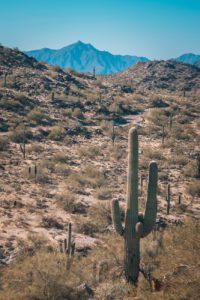PHOENIX, AZ – JUNE 2, 2020
Join us on this edition of Market Focus as we head down to Phoenix, the largest city (and state capital) of Arizona. The city’s metropolitan area is known as the “Valley of the Sun” and for good reason with over 300 sunny days a year! Nestled in the Salt River Valley, Phoenix is awash with a diverse blend of Native American, Latin American, and Wild West cultures, giving the city a unique identity that is reflected by its population, cuisines, museums, and performances. Opportunities for entertainment and recreation in Phoenix are endless!
Rental Trends
The average rent for a 1-bedroom apartment in Phoenix is $1,200 per month and $1,900 per month for a 3-bedroom apartment. The Phoenix housing market is much larger than just the city limits – it encompasses the entire Phoenix Metropolitan area.
The greater Phoenix area has incredibly low inventory on long-term rentals but fully furnished vacation rentals / VRBO homes are in good supply at this time due to many cancellations surrounding COVID-19. Prices have remained consistent thus far with the market prior to the shutdowns but it is common to have bidding wars driving up the rent on the most desirable homes. It’s important to move quickly and have the application and employment letter ready to submit as soon as possible. We anticipate demand to rise quickly as the country reopens.
Where to Live
Closer to the city, you’ll find that the most popular neighborhoods are North Mountain Village (average rent of $1,020 per month for 1-bedroom apartments), South Mountain Highland Terrace (average rent of $1,260), and Alhambra (average rent of $950). All of these are consistently ranked in Niche’s ‘Best Neighborhoods to Live in Phoenix’ yearly reports.
Some of the most affordable neighborhoods for 1-bedroom apartments in Phoenix are found in Estrella Village, Maryvale, and Alhambra. Biltmore, Desert View, and Downtown Phoenix are considered the most expensive due to their high-end shopping and dining destinations.
Phoenix suburbs like Chandler, Gilbert, and Ahwatukee are very popular for families. Due to their highly-ranked school districts, rental markets are very competitive and therefore a bit pricey. Scottsdale remains the most popular destination outside of Phoenix, as the schools there are considered the best in the valley and there are amazing recreational opportunities available. Another popular suburb is Tempe, which is a little more eclectic than downtown. This suburb is close to the ASU campus and is home to the very popular Tempe Lake, where you can row, kayak, and paddle-board.
Tips for RMCs, HR & Assignees
Phoenix is a HOT market by every definition of the word. As always, send applications to several properties that you are interested in pursuing.
Everyone knows Arizona is hot, but until you have lived there for a large portion of the summer you really don’t know just how intense the heat can be. You can expect temperatures at least in the 90s over summer and days can reach as high as 120 degrees Fahrenheit. Temperatures stay at least 100 degrees for nearly a third of the year! The Arizona heat is always something to consider when moving to Phoenix. You will want climate control options for moving and storing items, because things like fine wood furniture, instruments, art, and electronics are susceptible to heat damage. Please also be aware that anytime the temperature is over 100 degrees there is a risk of burning yourself on certain items, including door handles, steering wheels, or any metal on your car. We recommend purchasing a windshield sun shade, finding covered parking for your vehicle, and having a car with cloth seats (or buying seat covers). Bring plenty of cold water with you to ensure proper hydration in the hot sun, and consider a portable fan as well!
Arizona sees most of its tourists during the winter months, causing a major contrast between road traffic in the summer and the winter. Traffic jams are common in the winter because of the influx of people on the road. Phoenix has a decent public transportation system as well, featuring a 26-mile Light Rail and bus routes all over the city and surrounding area.
Whether or not you need a car depends mostly on where you live. The closer you get to the city center the easier you can get around without wheels. If you plan on living in areas outside downtown, a car will likely be a necessity. It’s not impossible to get around, but think twice before ditching your car for your daily commute!
Local Insights for Assignees
When you think of Phoenix you think of the outdoors! There are several hiking and off-roading trails around the area to enjoy, and on any given weekend you will find that there are hundreds of incredible attractions to explore.
A popular Phoenix attraction is the Desert Botanical Garden. This flora paradise spans 140 acres and is home to thousands of species of cacti, trees, and flowers from around the world. There are often art exhibitions on display across the park for visitors to enjoy.
Phoenix boasts over 200 golf courses, each one unique and strategically located throughout the city. It is also home to the largest professional golf tournament on the PGA Tour – The Phoenix Open.
Phoenix offers a full range of hiking trails for all levels of hikers. There are strenuous options like Sonoran Trail or Camelback Mountain, or you can find some easier trails at Papago Park or Lost Dog Wash Trailhead. No matter where you are in the greater Phoenix area, you’re guaranteed to be only a short drive away from a great trail to enjoy.
Prefer something indoors? Be sure to check out the world’s only global Musical Instrument Museum. This museum has over 7,000 instruments on display from 200 countries! Another great museum to explore is the Heard Museum, showcasing regional Native American art and culture.
